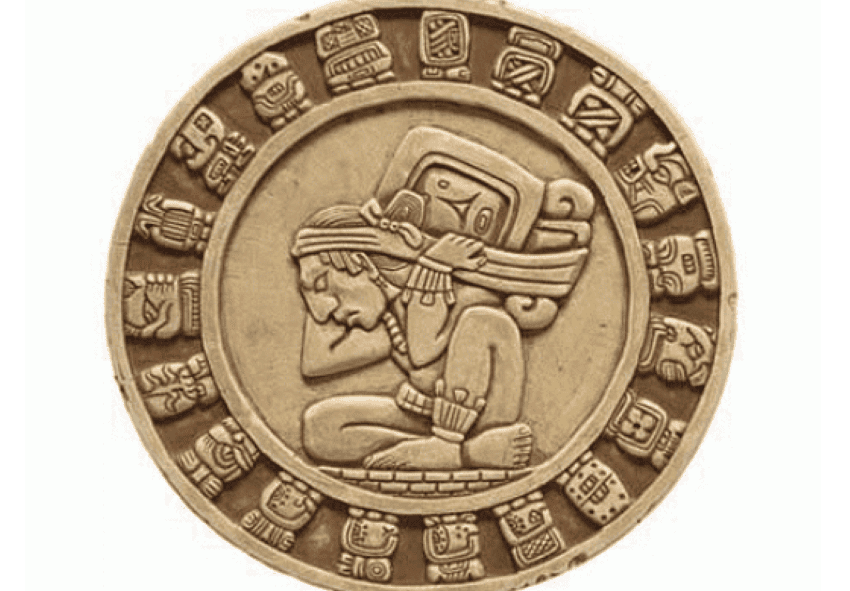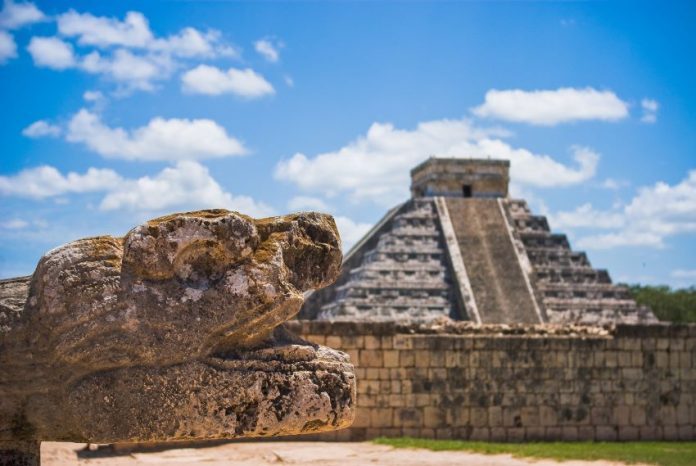As the shadow of the feathered serpent god descends towards the base of the Kukulkán pyramid, a bound prisoner is restrained over the sacrificial altar while the High Priest of Chichén Itzá raises his sharpened obsidian dagger overhead. With his body painted in sacred Maya Blue, the victim knows he will be offered to the rain god, Cháak, who opposes the new warlike serpent cult from Central Mexico that had conquered almost the entirety of the Yucatán Peninsula. When the shadow snake meets its end, so will he.
Hidden by the dense undergrowth of the Yucatán jungle, an ancient metropolis stands as a testimony to one of the most powerful and prosperous pre-Columbian civilizations. It was a place of pilgrimage with rituals involving human sacrifice, but also a place where art, astronomy and trade thrived, influencing lands far beyond those controlled by the Maya. Today, millions of people visit the famous Chichén Itzá archaeological site every year to marvel at its impressive stone pyramids and the mystery they left behind.

Chichén Itzá was abandoned centuries before the Spanish conquest of the Yucatán Peninsula, yet it maintained its prestigious aura and symbolic significance throughout the colonial period. Maya pilgrims continued to conduct ceremonies in honor of the rain god, Cháak, believed to reside in Xilbalbá (the underworld) beneath the Sacred Cenote of Chichén Itzá.
The site was populated for over a thousand years, during which cycles of prosperity and decline were influenced by political, religious and environmental events. Even today, it remains a Mecca for archaeologists, and adventurers the world over, with historical similarities of exponential prosperity comparable to the height of the Roman Empire.
So what makes Chichén Itzá so special when compared to other ancient cities around the world?
The metropolis was designed with the heavens in mind, tracking the movement of the stars in great detail and forecasting solar and lunar eclipses. The most recognizable structure in the city is the Temple of Kukulkán, also known as El Castillo. The building is positioned against the sun so that a shadow in the form of a serpent gradually crawls down the side of the pyramid during the equinox.
Yet, there is so much more behind the wonders and secrets of Chichén Itzá that archaeologists are still discovering today. For now, here is a glimpse of what we know about the lost city that captured the imagination of people around the globe for over a century:
The Water Witches and the magical cenotes of Chichén Itzá
The name of the city stems from the Itzá people (“magicians of the water”) who settled in the area sometime during the early ninth century. Chichén is taken from the Mayan phrase meaning “at the mouth of the well”, possibly due to the Maya spiritual connection with cenotes. Although little is known about the origins of this influential tribe, it is believed they migrated to Yucatán from the south, possibly from Guatemala or Belize.
Archaeological analyses of the older structures around the site point towards architectural techniques similar to those of the neighboring Puuc region to the south, with intricately carved masks and ornamental designs. Indeed, in its formative years, Chichén Itzá may have been under the influence of another powerful city-state like Yaxunah, which was connected by a sacbe (Maya road). But the new arrivals from the south would eventually see a renaissance ushering in a golden age that would see them construct some of the greatest pyramids in the Maya world.
![]()
The treasures of the Serpent Cult
Records taken from hieroglyphics found on the Tenoned Disk at the Caracol (snail) observatory at the site mention the arrival of the Toltecs from central Mexico. The Ancient Aztecs saw them as their cultural and intellectual forefathers who laid the groundwork for their advanced artistic and scientific success. Semi-mythical accounts described the Toltec capital, Tollan, as having buildings made out of solid jade and gold. With the coming of this central Mexican tribe with Mexica features of human sacrifice, bloodletting, and a thirst for war, a new religion spread across the Maya world around the early tenth century, eventually causing unrest and conflict with nonbelievers. It was during this period that Chichén Itzá experienced a building boom, and the serpent cult cemented its dominance, including regular blood sacrifice and self-mutilation for followers.
It was also when the most important pyramid on the site was constructed. El Castillo (The Castle) was built over the existing pyramid structures and became the main ritual site for the new religion that had conquered or assimilated its southern neighbors. Chichén Itzá was named as the cult’s southern capital city.
El Castillo was a temple dedicated to the main figure of the cult that evolved into a religious political movement, the feathered serpent called Kukulkán. Plumed snake sculptures adorn the northern balustrade, while a unique phenomenon occurs during the spring and autumn equinoxes. At this time, the late afternoon sun casts triangular shadows against the northwest balustrade, creating the illusion of Kukulkán gradually crawling down the pyramid. Unbelievably, this amazing astrological precision survives today and the feathered serpent continues to appear on the same dates.
The Exodus
Experts say the Chichén Itzá renaissance under the serpent cult could have been as brief as a few decades or as long as 150 years. However, Paleoclimate data collected in a 2018 study indicates an increase in aridity throughout the region, which points to a decline sometime around the eleventh century. According to remnants of ceremonial pottery and other evidence, the inhabitants of Chichén Itzá were deeply concerned with drought and soil fertility, and by 1100 AD, population levels had dropped significantly.
“Chichén Itzá, however, was never completely abandoned or unoccupied,” the study says. “It remained an important place for pilgrims throughout the Late Postclassic and even during the colonial period. Chichén Itzá was an American Mecca. Today, it sees more visitors than ever before.”
The ancient metropolis was voted one of the New Seven Wonders of the World in 2007 for good reason. Meanwhile, improved technology is revealing secrets hidden underneath the jungle canopy for centuries, challenging mainstream narratives about the scale and influence of the pre-Columbian Maya people. Despite almost 100 years of analysis from global experts, we are unable to fully explain the origins of the Maya, their golden age and their eventual tragic demise. However, while archaeologists struggle to connect the pieces of the Ancient Maya puzzle, the great Maya pyramids of Chichén Itzá continue to fill our minds with spectacle and wonder.
Mark Viales writes for Mexico News Daily.
